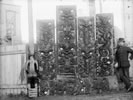‘Unworthy of attention’
Until well into the 20th century, Māori rock art was popularly little known in comparison with other Māori art forms such as carving and weaving. Some non-Māori insisted that the rock artworks were all of recent origin, and not worthy of serious scientific attention. There were limited efforts to accurately record or preserve the country’s legacy of Māori rock art.
Unlike the cave drawings of Australia and Europe, many Māori artworks were on limestone faces that were exposed to the weather, and they were prone to fading. Few were fenced off from stock, which sheltered in the same overhangs that the image-makers chose for their work.
First copies of artworks
The surveyor Walter Mantell was one of the first Europeans known to record Māori rock art. In 1852 he sketched ‘rude figures’1 painted on an overhanging cliff face in North Otago. Later the scientist Julius Haast and ethnologist Augustus Hamilton made more comprehensive records. Hamilton was the first person to systematically photograph rock art, and his images were published in 1898. In the early 20th century an American collector, J. L. Elmore, made further records, now held in Dunedin’s Hocken Library.
None of these men, however, had the financial resources to make comprehensive and accurate copies of the actual work, instead preferring to select those images they found most interesting.
‘Improving’ the originals
Some recorders retouched paint on the original artworks to ‘improve’ them for photographic recording – outlining them in chalk, touching them up with modern art materials such as ink and crayon and, in at least one case, painting over the images with house paint.
‘Uncanny and frozen music’
Theo Schoon persevered, in the face of formidable difficulties, to record, interpret and celebrate Māori rock art. The government turned down his request for a car. He became ill working in exposed conditions during harsh southern winters. He sometimes had to support himself by labouring, or painting commissioned portraits for the farmers on whose land he worked. Yet he found the project deeply rewarding, both personally and artistically. ‘Again and again I have found the most surprising original creations – major artistic feats, which border on uncanny and frozen music’.2
Theo Schoon
New Zealand’s early rock art remained largely unknown, while elsewhere in the world prehistoric images such as those found in the Lascaux Caves in France greatly influenced artists such as Picasso. In 1945, however, an artist named Theo Schoon, who had gained an appreciation of non-Western art while living in Java, was struck by reproductions of rock drawings in the Otago Museum. He was engaged by the Canterbury Museum to copy drawings at Craigmore and Pareora in South Canterbury. Schoon was then commissioned by the Department of Internal Affairs to make copies of rock art in Canterbury, North Otago and Kaikōura.
Over the next eight years, often in extremely demanding conditions, Schoon painted copies of Māori rock art. He rendered them in his own unique style, and sometimes retouched them with crayon to make the shapes more distinct. He believed that at least some of the drawings were made with sacred ritualistic intent: ‘Like the priest, the artist was a link between man and the supernatural.’3 This view has subsequently been questioned by some archaeologists.
Artists respond
Theo Schoon encouraged New Zealand and European journalists to write about Māori rock art, and other artists, including Gordon Walters, came to share his enthusiasm. A. R. D. Fairburn, although better known as a poet, hand-printed rock art designs on fabrics which became fashionable for interior decoration in the 1960s. Artist Tony Fomison made further accurate records of rock art, painstakingly tracing some onto plastic. He identified five phases of design styles, organised by the extent of realism and the varied use of reds or blacks. His last period was the time after Māori had contact with Europeans.
Saving threatened sites
Rock art continued to suffer damage from vandalism, weathering and agricultural or industrial activities such as roadworks and hydroelectricity schemes. A notable action came in the 1980s, when the Elworthy family, in conjunction with others, placed covenants on their property at Craigmore to permanently protect its outstanding shelter art.
Archaeological study
From the mid-1960s archaeologists conducted rigorous scientific studies of Māori rock art, and more sites were placed under permanent state protection. Ancient Māori designs in rock art and other media eventually featured in modern art worldwide, and were regarded as a priceless relic of New Zealand’s prehistory.








